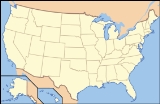
Fossil Butte National Monument
Encyclopedia
Fossil Butte National Monument is a unit of the National Park Service
located 15 miles west of Kemmerer, Wyoming
; the national monument
was established on October 23, 1972. The site preserves the best paleontological record of Tertiary aquatic communities in North America and possibly the world, within the 50-million-year-old Green River
lake beds. Fossils preserved, including fish, alligators, bats, turtles, dog-sized horses, insects, and many other species of plants and animals suggest that the region was a low, subtropical, freshwater basin when the sediments accumulated, over about a 2 million-year period.
Coal mining for the railroad led to the settlement of the nearby town of Fossil, Wyoming, now a ghost town
. When the fossils were discovered, miners dug them up to sell to collectors. In particular, Lee Craig sold fossils from 1897 to 1937. Commercial fossil collecting is not allowed within the National Monument, but numerous quarries on private land nearby continue to produce extraordinary fossil specimens, both for museums and for private collectors.
During the summer, lab personnel prepare fossils in public. Summer activities also include ranger programs, hikes, paleontology and geology talks, and participation in fossil quarry collections for the park.
A Junior Ranger program can be completed by children aged 5–12 (with exercises scaled to the child's age) in 3–4 hours. A highlight is hiking 3/4 mile up the butte to the dig, where interns from the Geological Society of America talk about their excavation and let children help them flake apart sedimentary deposits to discover fish fossils and coprolites.
National Park Service
The National Park Service is the U.S. federal agency that manages all national parks, many national monuments, and other conservation and historical properties with various title designations...
located 15 miles west of Kemmerer, Wyoming
Kemmerer, Wyoming
Kemmerer is both the largest city and the county seat of Lincoln County, Wyoming, United States. The population was 2,651 at the 2000 census. It dubs itself the "The Fossil Fish Capital of the World" and the "Gateway to the West." As the county seat of Lincoln County, Kemmerer is the location of...
; the national monument
U.S. National Monument
A National Monument in the United States is a protected area that is similar to a National Park except that the President of the United States can quickly declare an area of the United States to be a National Monument without the approval of Congress. National monuments receive less funding and...
was established on October 23, 1972. The site preserves the best paleontological record of Tertiary aquatic communities in North America and possibly the world, within the 50-million-year-old Green River
Green River Formation
The Green River Formation is an Eocene geologic formation that records the sedimentation in a group of intermountain lakes. The sediments are deposited in very fine layers, a dark layer during the growing season and a light-hue inorganic layer in winter. Each pair of layers is called a varve and...
lake beds. Fossils preserved, including fish, alligators, bats, turtles, dog-sized horses, insects, and many other species of plants and animals suggest that the region was a low, subtropical, freshwater basin when the sediments accumulated, over about a 2 million-year period.
Coal mining for the railroad led to the settlement of the nearby town of Fossil, Wyoming, now a ghost town
Ghost town
A ghost town is an abandoned town or city. A town often becomes a ghost town because the economic activity that supported it has failed, or due to natural or human-caused disasters such as floods, government actions, uncontrolled lawlessness, war, or nuclear disasters...
. When the fossils were discovered, miners dug them up to sell to collectors. In particular, Lee Craig sold fossils from 1897 to 1937. Commercial fossil collecting is not allowed within the National Monument, but numerous quarries on private land nearby continue to produce extraordinary fossil specimens, both for museums and for private collectors.
Exhibits and Activities
The Visitor Center features over 80 fossils and fossil casts on exhibit, including fish, a crocodile, turtle, bats, birds, insects and plants. A 13-minute video is shown about the fossils found at the site and what scientists have learned. Interactive exhibits let visitors create fossil rubbings to take home, and a computer program discusses fossils, geology and the current natural history of the monument.During the summer, lab personnel prepare fossils in public. Summer activities also include ranger programs, hikes, paleontology and geology talks, and participation in fossil quarry collections for the park.
A Junior Ranger program can be completed by children aged 5–12 (with exercises scaled to the child's age) in 3–4 hours. A highlight is hiking 3/4 mile up the butte to the dig, where interns from the Geological Society of America talk about their excavation and let children help them flake apart sedimentary deposits to discover fish fossils and coprolites.
External links
- National Park Service Official Site
- Photo tour of FBNM, from USGS
- Paleontology of Green River fossils, from University of California, BerkeleyUniversity of California, BerkeleyThe University of California, Berkeley , is a teaching and research university established in 1868 and located in Berkeley, California, USA...
- Geologic travel guide from American Geological InstituteAmerican Geological InstituteThe American Geosciences Institute is a nonprofit federation of 45 geoscientific and professional associations that represents more than 100,000 geologists, geophysicists, and other earth scientists...

